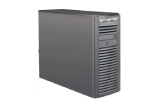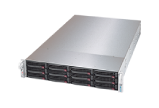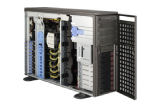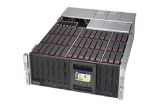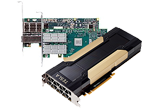ソフトウェア
VMD
VMDは米イリノイ大学アーバナ・シャンペーン校のTheoretical and Computational Biophysics Group (TCB)とParallel Programming Laboratory (PPL)との共同研究により開発された計算プログラムNAMDに対応した無償で入手可能なプリポストプログラムです。ビューワーとして、タンパク質、核酸、脂質二重層アセンブリのような生物学的システムのモデル化、可視化、分析のために設計されています。NAMDだけではなく対応プログラムが非常に多彩で、AMBER、VASP、GAMESS、GROMACSなどの計算結果の可視化も可能です。
Status
名称: VMD
最新バージョン:1.9.3
リリースノート:
https://www.ks.uiuc.edu/Research/vmd/current/README.html
What’s new in VMD 1.9.3?
————————
New platform support:
o Added support for Cray XC50 supercomputers with NVIDIA P100 GPUs.
o Support for Intel Xeon Phi Knight’s Landing CPUs with AVX-512
vector instructions, specifically targeting early science projects
running on the TACC Stampede-2 and ALCF Theta supercomputers:
http://www.ks.uiuc.edu/Research/vmd/vmd-1.9.3/avx512.html
o Support for IBM POWER8 CPUs and the new “Minsky” compute node
that incorporates NVIDIA P100 GPUs attached via NVLink,
for the upcoming ORNL CAAR early access system:
http://dx.doi.org/10.1007/978-3-319-46079-6_14
o Support for a range of ARM processors paired with GPUs:
http://dx.doi.org/10.1109/IPDPSW.2016.130
New Features and Performance Improvements
o New QwikMD integrative MD simulation tool guides users in
preparing, running, and analyzing MD simulations:
http://dx.doi.org/10.1038/srep26536
http://www.ks.uiuc.edu/Research/qwikmd/
o Automated Topology Conversion from CHARMM to GROMACS with
the topotools plugin “topogromacs” feature:
http://dx.doi.org/10.1021/acs.jcim.6b00103
o New TachyonL-OSPray ray tracing engine for Intel x86 and Xeon Phi
CPUs (including Knights Landing aka KNL) speeds up high quality image
and movie renderings, particularly for scenes using ambient occlusion
lighting and shadows.
http://dx.doi.org/10.1109/TVCG.2016.2599041
o Faster TachyonL-OptiX GPU-accelerated ray tracing engine
supports rendering of VR movies for YouTube with display
by Google Cardboard, GearVR, Oculus Rift, etc:
http://dx.doi.org/10.1016/j.parco.2015.10.015
The new version also speeds up high quality image and movie renderings,
particularly for scenes using ambient occlusion lighting and shadows:
http://dx.doi.org/10.1145/2535571.2535595
http://dx.doi.org/10.1109/IPDPSW.2016.121
o VMD supports off-screen OpenGL rendering with both traditional
GLX (with a windowing system) and with EGL (without a windowing system),
enabling large scale parallel visualization runs on “headless”
clouds, clusters, and petascale computers, using the
“-dispdev openglpbuffer” flag:
https://cug.org/proceedings/cug2014_proceedings/includes/files/pap110.pdf
http://dx.doi.org/10.1109/IPDPSW.2016.127
Other updates and improvements
o Improved the robustness of the QuickSurf representation for display
of very large biomolecular complexes such as viruses, coarse grained
models, and corrected behavior for some unusual structures.
o Fast GPU-accelerated quality-of-fit cross correlation enables
analysis of results from molecular dynamics flexible fitting (MDFF)
and other hybrid structure determination methods:
http://dx.doi.org/10.1039/C4FD00005F
http://dx.doi.org/10.1007/978-3-319-46079-6_14
o VMD includes a built-in implementation of the collective variables
feature also implemented in NAMD, enabling easier preparation
and analysis of NAMD simulations using collective variables:
http://dx.doi.org/10.1080/00268976.2013.813594
o Built-in support for parallel analysis and visualization using
MPI, with VMD “parallel” commands:
http://dx.doi.org/10.1109/XSW.2013.10
http://dx.doi.org/10.1109/HPTCDL.2014.7
o FFTK: The Force Field Toolkit (FFTK) plugin is a set of tools
that aid users in the development of CHARMM-compatible force
field parameters, including: charges, bonds, angles, and dihedrals
http://www.ks.uiuc.edu/Research/vmd/plugins/fftk/
o Bendix: calculates and visualizes both dynamic and static
helix geometry, and abstracts helices without sacrificing conformation:
http://sbcb.bioch.ox.ac.uk/Bendix/
o Modified TkCon to prevent it from sourcing command line args
as script files at startup.
o Updated support for compilation of VMD with Tcl 8.6.x
New and improved file import and export
o pdbxplugin: support for the RCSB PDB “PDBx” format.
o ccp4plugin: support for many new IMOD tomography voxel formats
o vtkplugin: New VTK grid reader plugin
o raster3dplugin: Patch to correct the Raster3D reader plugin for
some Molscript output files that previously didn’t work right
o lammpsplugin:
Replaced the quicksort based index sorting with a mergesort,
thereby avoiding the worst-case O(N^2) quicksort performance
pitfall that arises when it is presented with an already-sorted list.
Eliminated compiler warnings on missing return value from
internal id_merge() function.
o babelplugin: Updated minor version number to reflect alternate code
paths added to the VMD directory/path traversal code in vmddir.h
o dtrplugin: Applied patch to cause the dtrplugin code to use
PRIu64 macros rather than hard-coded format conversion specifiers when
scanning or printing 64-bit values for various internal quantities.
o graspplugin: Eliminated test for negative value on an
unsigned integer type.
o parmplugin, parm7plugin: Prevent code injection attacks
on the auto-decompression code path.
o gamessplugin: Corrected uninitialized pointer.
o offplugin: Added support for handling of Windows line breaks
and a suspicious index check.
o vaspxmlplugin: Correction for null termination of string.
o maeffplugin: Correction to console exception reporting case.
o moldenplugin: Correct an uninitialized pointer.
o jsplugin: Auto-enable SSD-optimized unbuffered block-based I/O for
all structures with more than 50,000 atoms, for which alignment
padding overhead for on-disk and in-memory data structures are
under 1% on average. Emit more diagnostic information in cases where
the Linux kernel returns errors and does not do partial writes.
o dcdplugin: eliminate compiler warning on IBM Power8
o dlpolyplugin: Updated dlpoly plugin support DLPOLY V4 history files,
and to make a distinction between classic DLPOLY files and those
produced by DLPOLY V4.
o plyplugin: Misc cleanup and bug fixes for the PLY plugin
User documentation updates
o Minor improvements and corrections to the VMD User’s Guide,
added documentation for new commands, graphical representations,
and environment variables.
Bug fixes and small improvements
o fftk: misc small bug fixes.
o Updated the VMD copy of WKFThreads from the latest version of Tachyon.
VMD配布バイナリーのインストール
VMDの最新バージョンは1.9.4です。開発元で配布されているバイナリをダウンロードして使用されている方も多い事と思いますが、時おり、この配布バイナリが上手く動作しないのでなんとかしてほしいとのご要望をいただく場合があります。そこで簡単ですが、配布バイナリのインストール方法に関して解説します。
インストール方法
まず、
http://www.ks.uiuc.edu/Research/vmd/
より、ライセンスアグリメントに同意して、linuxのx86-64版のバイナリをダウンロードします。
(vmd-1.9.bin.LINUXAMD64.opengl.tar.gz)
次にこれを展開します。よく誤解される事なのですが、配布バイナリはこのままでも動作する環境の場合は動作しますが、ただ展開しただけは配布元が期待しているインストール方法が終わった訳では無いという事です。
配布されているバイナリはcudaを使用する事も可能なようにビルドされているので、cudaをインストールしていない場合は、大抵、libcudart.so が無いとエラーが出て動かないはずです。
配布バイナリは、多用な環境に対応して、更に、オプションなどが変更出来るようになっています。
配布バイナリにsrcそれ自体が入っていないにもかかわらず、srcというディレクトリがあるのはこの為です。
配布バイナリのトップディレクトリにはconfigureとconfigure.optionsのファイルがありますが、これはインストール用で、vmdで使うライブラリは、configure.optionsに列記してありますが、CUDAを使用しない場合は、この中のCUDAの部分を消します。
その次に、configureを実行します。
そして、srcの下に移動して、rootでmake installとコマンドを打つと、
/usr/local/binと/usr/local/lib
にインストールされます。
※ 会社名・製品名・サービス名などは一般に各社の登録商標または商標です。
※ 製品の仕様、構成、価格などは、予告なく変更される場合があります。ご了承ください。
※ 製品の色調は実際と異なる場合があります。
お問い合わせ
平日9:30~17:30 (土曜日、日曜日、祝祭日、年末年始、夏期休暇は、休日とさせていただきます。)

